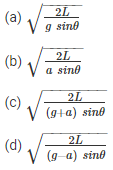NEET Physics is the scoring paper in the medical entrance examination. Here, you will discover the NEET Physics MCQ Questions for all Concepts as per the latest syllabus. Practice more on a regular basis with these NEET Physics objective questions on air pollution and improve your subject knowledge & problem-solving skills along with time management. NEET Physics Laws of motion Multiple Choice Questions make you feel confident in answering the question in the exam & increases your scores to high.
MCQ on Laws of motion
1. A particle of mass m is given an impulse such that the velocity of the particle changes from v1 to v2. The impulse is equal to
(a) m(v2 + v1)
(b) m (v2 – v1)
(c) m (|v2|-|v1|)
(d) \(\frac{1}{2}\left(v_{2}^{2}-v_{1}^{2}\right)\)
Answer
Answer: (b) m (v2 – v1)
2. What is the time taken by the body to slide down an inclined plane if the length of the inclined plane is L, a as the retardation, and Ө is the angle of inclination.

Answer
Answer: (c) \(\sqrt{\frac{2 L}{(g+a) \sin \theta}}\)
3. Choose the correct statement
(a) A body can be accelerated by frictional force
(b) There can be zero friction
(c) Kinetic friction is greater than rolling friction
(d) Frictional force and area of contact between the two surfaces are proportional
Answer
Answer: (c) Kinetic friction is greater than rolling friction
4. Consider a car that overturns while taking a turn. Select the option that is experienced by the wheels of the car.
(a) First, both inner, as well as the outer wheel, leave the ground
(b) First, the inner wheel leaves the ground
(c) The inner wheel experiences no change
(d) None of the above
Answer
Answer: (b) First, the inner wheel leaves the ground
5. Let two bodies be with masses 2kg and 5kg respectively. Let these bodies be at rest with the same force acting on them. Calculate the ratio of times that is required by both the bodies to reach the final velocity.
(a) 2:5
(b) 25:4
(c) 5:3
(d) 4:25
Answer
Answer: (a) 2:5
6. What is the force acting on the particle if the motion of the particle is given as \(y=u t+\frac{1}{2} g t^{2}\)
(a) F = ma
(b) F = 0
(c) F = mg
(d) F ≠ 0
Answer
Answer: (c) F = mg
7. Consider two bodies of masses A and B such that these two bodies are connected by using a massless spring. Also, force F is acting on the body B. What will be the acceleration of B if A has an acceleration of a?

(a) a
(b) F – T
(c) \(\left(\frac{F}{m}-a\right)\)
(d) \(\left(a-\frac{F}{m}\right)\)
Answer
Answer: (c) \(\left(\frac{F}{m}-a\right)\)
8. Let A, B, and C be the three blocks of mass 2kg each. These blocks are hanging over a pulley with the help of a string. What is the tension produced by the string connecting B and C?

(a) 3.3N
(b) 0
(c) 13.1N
(d) 19.6N
Answer
Answer: (c) 13.1N
9. Consider three masses of 1kg, 3kg and 6kg which are connected to each other and are placed horizontally on the table. Calculate the acceleration of this system. Consider g = 10m/s.

(a) 3
(b) 0
(c) 1
(d) 2
Answer
Answer: (d) 2
10. From the following diagram, select the correct diagram when a vessel containing water is given a constant acceleration towards the right along the straight line.

Answer
Answer: (c)
11. Consider a man standing on the spring balance such that the reading on the spring balance is 60kg. If the man jumps out of the spring balance what will be the final reading of the spring balance?
(a) Remains unchanged
(b) Increases
(c) Decreases
(d) First increases then decrease to zero
Answer
Answer: (d) First increases then decreases to zero
12. Which of the following should be constant for a body to have a constant momentum?
(a) Acceleration
(b) Force
(c) Velocity
(d) All of the above
Answer
Answer: (d) All of the above
